‘You have to remember that life at the time was very dangerous. I didn’t let anyone official see my work and the studio was always locked. And that went on for 30 years.’ Ilya Kabakov (b. 1933) is speaking about his life as an ‘unofficial’ artist in the Soviet Union, which he left in 1987. The contrast between the close circle of friends who were allowed to see his studio-bound work then and the international audiences who have seen his immersive installations and large-scale paintings in the last two decades, and between that Moscow studio and the Long Island home, where he lives and works today, couldn’t, it seems, be greater. But perhaps the most important difference is that he is now part of a formidable team and has a collaborator, in the figure of his wife Emilia (b. 1945), with whom he has worked since 1988, and who has shared the credit on all the works, except for the paintings, since 1997.
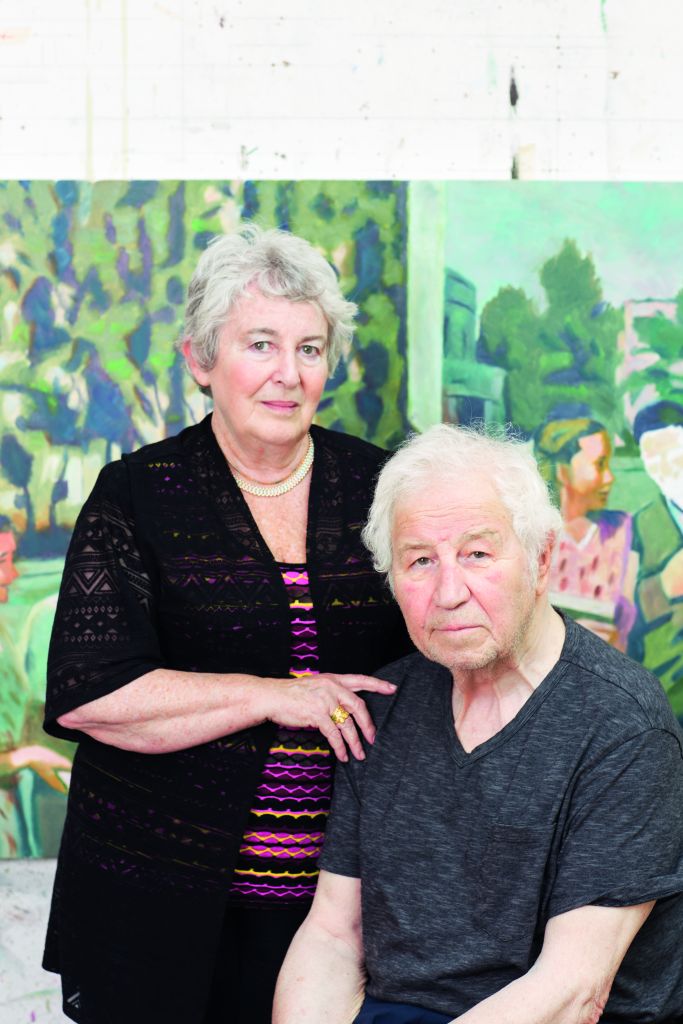
Ilya and Emilia Kabakov photographed in Long Island, July 2017. Photo: Dina Kantor
It is early July and Ilya and Emilia Kabakov are preparing for two exhibitions. The first is a presentation at the Hirshhorn Museum in Washington, D.C., of maquettes, the wooden models created for the pair’s many installations and public artworks all over the world, for both realised and unrealised projects (7 September–4 March 2018). The second is a much bigger affair – the first exhibition the Kabakovs themselves regard as a retrospective – which opens at Tate Modern this month (18 October–28 January 2018), before moving to the State Hermitage Museum in St Petersburg, and then the State Tretyakov Gallery in Moscow. The Kabakovs have exhibited in Russia before, including at the Hermitage Museum, but the scale of the upcoming shows reveals just how much attitudes towards contemporary art have changed in the country’s major art institutions in a relatively short time. As Ilya Kabakov recalls animatedly, Irina Antonova, the former director of the Pushkin State Museum of Fine Arts, who held the post from 1961–2013, is reported to have said, ‘As long I’m alive Kabakov is not going to be in my museum. Installation is not art.’ (When there was an exhibition of the Kabakovs’ work in 2008 across multiple venues in Moscow, at the Garage Center for Contemporary Art, the Contemporary Art Center Winzavod, and the Pushkin, the director of the latter was conspicuously absent from the opening.)
Ilya and Emilia Kabakov, who are cousins, were both born in the city of Dnepropetrovsk in what is now Ukraine. After an all-round fine arts education – ‘in this sense Russian art education was very good’ – at the Moscow School of Fine Arts, Ilya Kabakov studied illustration at the Surikov Art Institute and deliberately chose to make a living as an illustrator of children’s books, working for various state publishing houses. He is entirely dismissive of the work – ‘I don’t like illustration’ – insisting that he took it because ‘It was the easiest way to make money’. It was so well paid (and overheads in the USSR so low) that he needed to work for only two or three months a year – ‘the other nine months was my time’. It was, as Kabakov puts it, ‘a unique situation’, but he recommends the separation of activities to every artist who can make it work.
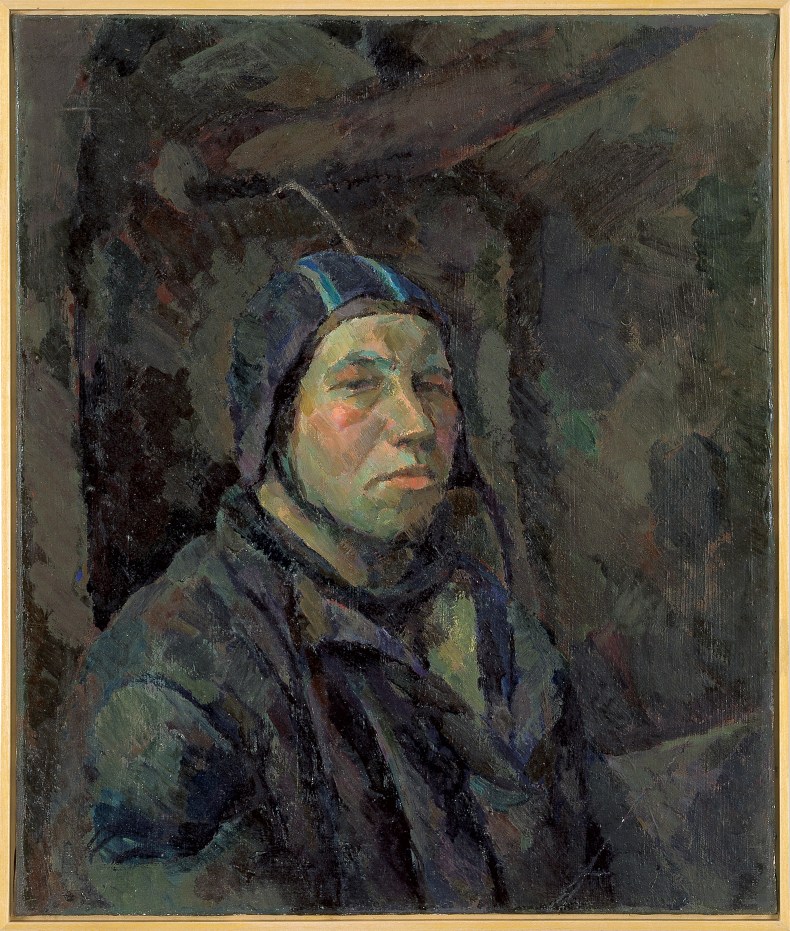
Self Portrait (1962), Ilya Kabakov. Private collection. © Ilya and Emilia Kabakov
At the same time he was drawing and painting for himself, cycling through different styles and media. Emilia Kabakov says, ‘He didn’t have any examples. He was trying to do what socialist realism wasn’t doing.’ The Bush (1961) and a Self-Portrait (1962) are conventional oil paintings on canvas, with nods to Cézanne; other early works make do with the materials available to an artist working outside the officially approved art system. These early paintings are a world away from the heroic conceptions of workers associated with socialist realism, the only officially sanctioned artistic style – ‘national in form and socialist in content’ – of the Soviet Union after 1934. Soccer Player (1964), which Ilya Kabakov has described as his first conceptual painting, is executed on masonite, a cheap building material. Against a blue background, the outline of a footballer is filled in with an insipid rural landscape. The player’s foot is pointed at the word ‘Uglich’ written in Cyrillic script, above which are two yellow discs and a pale blue rectangle, which could have floated across from a Suprematist or Constructivist composition. The soccer player here is some kind of cousin to El Lissitzky’s The Footballer (1922), a photomontage of a figure among geometrical forms. But the Kabakov painting is complicated by the writing – Uglich is a historic town north of Moscow and also home to one of the USSR’s first hydroelectric power stations, built by forced labour in the 1930s. The piling up of different elements – a landscape confined within the outlines of a figure; a rural painting with an industrial label – and the difficulty of pinning down the meaning of the juxtapositions, is typical of Ilya Kabakov’s paintings.
By the early 1970s, there was a group of Moscow-based artists, who met regularly at Kabakov’s studio in the centre of the city. These ‘nonconformist’ artists included Erik Bulatov, Viktor Pivovarov, Vladimir Yankilevsky, and Oleg Vassiliev. Ilya Kabakov speaks fondly yet dispassionately of the scene. There were no opportunities to exhibit, no curators or art critics. It was, he says, ‘a complete vacuum of artistic life’, a vacuum that Kabakov and his friends filled by acting as ‘art critics and collectors for each other’, by putting on exhibitions for each other and giving each other advice.
Emilia, who is translating for me, switches for the only time to answering for Ilya: ‘The main problem was that they didn’t have an open situation, they couldn’t compare to anything else’ – before resuming translation mode: ‘Everybody of course, you understand, was telling each other, “You are a genius.” It’s the same situation as if you’re playing tennis in your backyard with your friends. You don’t know if you play well, if you play badly, if you can play at Wimbledon; you don’t know if you could qualify.’
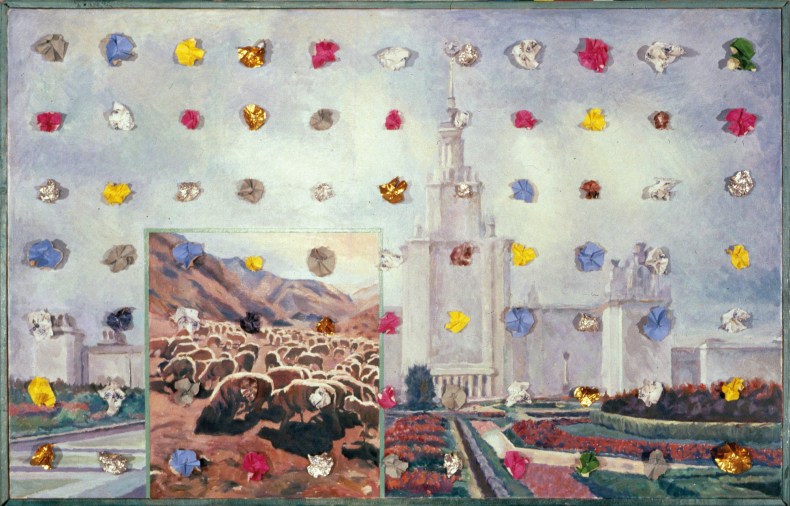
Holiday #1 (1987), Ilya Kabakov. © Ilya and Emilia Kabakov
From 1972 to 1975, Kabakov worked on a set of 10 albums, each devoted to different Soviet character types. The albums consisted of loose sheets, numbering between 32 and 72 pages, and were covered in drawings and handwritten text and placed in cardboard boxes, with characters including the obsessively rational The Mathematical Gorsky, the escapist Anna Petrovna Has a Dream, and the reclusive Sitting-in-the-Closet-Primakov. Kabakov would ‘perform’ these albums by placing them on a lectern in front of his select audience, turning the pages, and reading the texts aloud.
Kabakov’s interest in storytelling and fictional personas extends to his paintings. The conceit of the 12 paintings in his Holiday series of large oil and enamel works on canvas is that they are by a not very good official artist, diligently working away in a socialist-realist vein for a public commission. The artist rediscovers the works in storage – the commission was cancelled – and tries to improve on his previous efforts by sewing sweet wrappers on to the canvases and inserting scenes from other works to liven them up. Holiday #1 (1987), for instance, imposes a flock of grazing sheep on to a view of a Stalinist building.
Working in series, reworking pieces, and assuming characters, is a common feature of the Kabakovs’ work. When it comes to the paintings, Emilia says of Ilya, ‘Sometimes it can be one painting and that’s it. Sometimes it could be 22, 25 paintings until he feels there’s nothing else to say about it.’ Ilya continues: ‘I become obsessive. There are people who say one word and they think they have said enough to be understood. I think I have to repeat everything a few times because I want people to understand my idea.’
The premise of a more recent series, Six Paintings about the Temporary Loss of Eyesight (2015) is obvious, but Emilia is quick to point out that the paintings about an ageing artist worried about his vision are as fictional as any of the installations based on Soviet communal apartments: ‘What people don’t understand is that a person works in fantasy – neither he nor I ever lived in communal apartments, although our parents did.’
Emilia Kabakov’s theory about why Ilya Kabakov has so many painterly alter-egos is appealingly matter-of-fact: ‘My feeling, and maybe I’m wrong, is that before – because of the situation – he was always scared to say “I did this painting, it’s my work.” […] But now, being the age he is, he’s finally brave enough to be responsible for what he does. Now it’s Kabakov and “Say whatever you want. I can handle it”.’
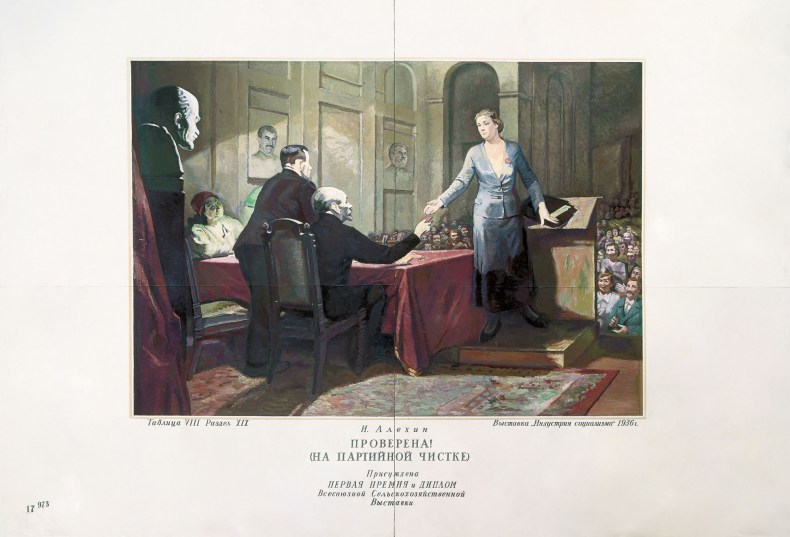
Tested! (1981), Ilya Kabakov. © Ilya and Emilia Kabakov
Emilia Kabakov left the USSR in 1973 – it was Ilya who took her to the train station – moving first to Israel, then the US, where she worked as a dealer and art adviser – she is good on Americana as well as Fabergé she says. She comes across as impeccably capable, businesslike, and organised – she describes herself as ‘a pathological archivist’; she has tirelessly tracked down all of Ilya Kabakov’s pre-1987 works. For a long time, the only work left unaccounted for was Soccer Player, until she was contacted by an auction house and by someone else who thought that this work by ‘Ilya Kabakov’ might be a fake. The owner asked Emilia Kabakov to place a specified amount for the painting in an escrow account in exchange for being allowed to look at the work at the auction house. ‘We agreed that if it was okay, I would take the painting and they would take the money…I looked at the painting […] and when it was already in the crate I said, by the way, this is the first conceptual painting he made. “Why didn’t you tell us before?” they said. Why should I?’ she laughs.
Ilya Kabakov didn’t leave the Soviet Union until 1987, when the thawing of the glasnost period meant that he was allowed to visit Austria, and he didn’t return. In 1992, he moved to the US, where he has lived ever since. He already had a reputation among the Western curators, such as Jean-Hubert Martin, a particular champion of the Kabakovs’ work, who had visited Moscow and the artists of the underground scene in the early 1980s.
Emilia Kabakov, who trained as a musician, and was aiming to be a professional pianist (she also has a degree in Spanish from the Moscow State University), was reluctant to think of herself an artist when she and Ilya started working together. ‘It was a very interesting situation, learning, watching him,’ Emilia says. ‘He is manic-obsessive,’ she adds cheerfully. ‘I would say I was more of an assistant than a partner at first. But I also learned very fast and, fortunately or unfortunately, I have a mind of my own as well.’
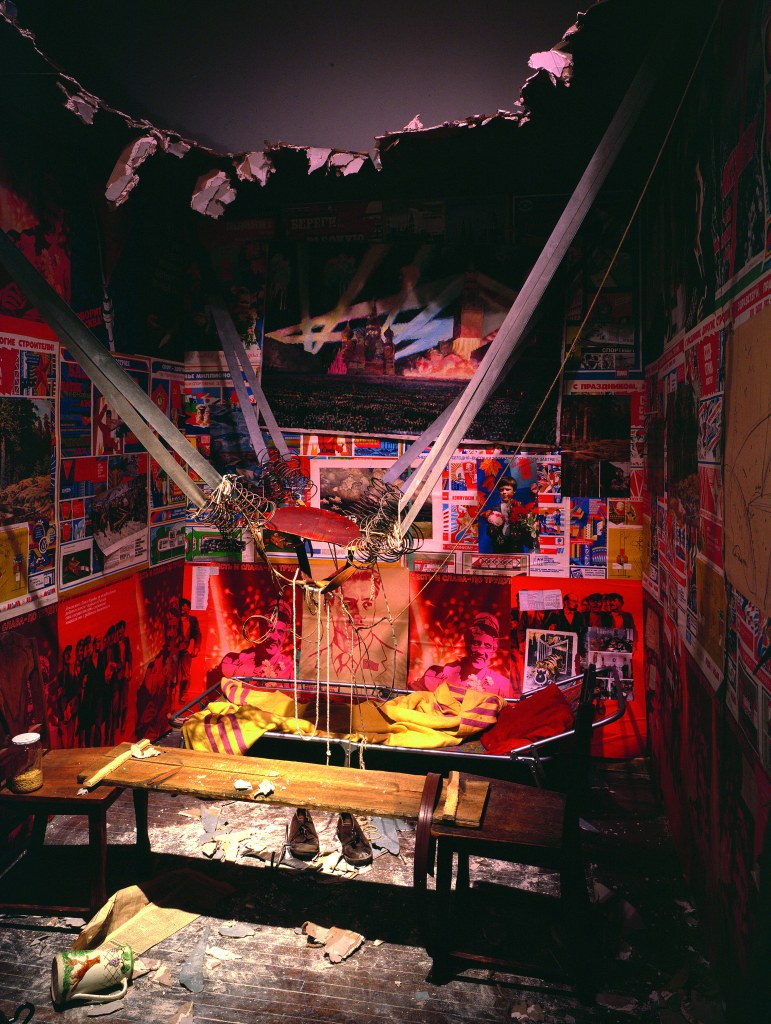
The Man Who Flew Into Space From His Apartment (1985), Ilya Kabakov. Centre Pompidou, Paris. © Ilya and Emilia Kabakov
Of the room-size installations the pair are best known for, the earliest is The Man Who Flew Into Space from His Apartment (1985), which Ilya Kabakov first created in his Moscow studio – the only installation he ever showed there. In this absurd scenario, through a boarded-up doorway, we can see into the clutter of a communal apartment, the occupant of which has catapulted himself into space using a home-made device. All that is left are the walls covered in propaganda posters (with heroes such as Lenin on the top level), diagrams of the man’s contraption for escape, and a model of his trajectory over the city block.
Neither of the Kabakovs regard the Stalinist regime or, later, the stultifying Brezhnev period with any nostalgia, but it seems reductive to view their work as nothing but a critique of socialist realism and the system that endorsed it. An oeuvre so closely tied to the object of its mockery – especially if that object had no merit at all – would soon be of merely antiquarian interest. There’s a tension in The Man Who Flew Into Space From His Apartment, for example, between the absurdity of the protagonist trying to escape an earthbound utopia that hasn’t panned out for a celestial version that will kill him – and being inspired by state propaganda to achieve this lethal personal freedom.
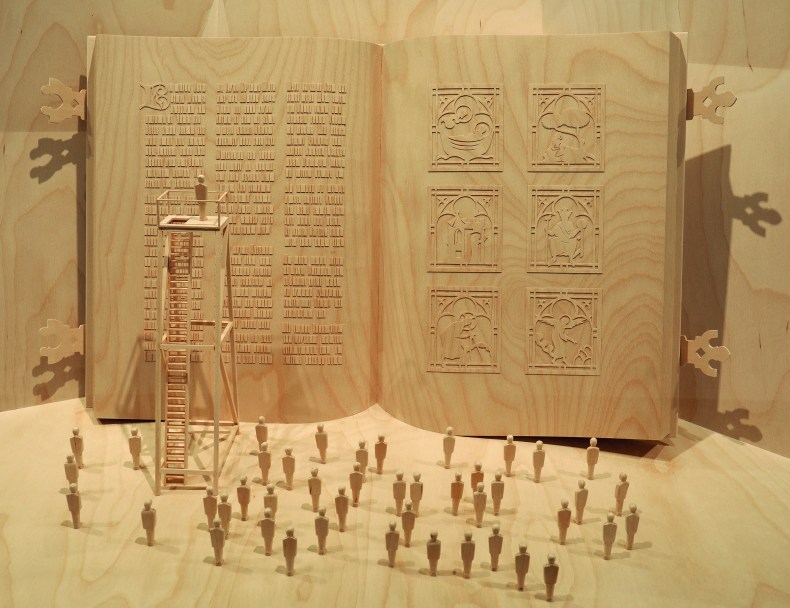
Model for Ilya and Emilia Kabakov’s unrealised project The Largest Book in the World (2015). Photo: Cathy Carver; courtesy Hirshhorn Museum and Sculpture Garden; © Ilya and Emilia Kabakov
The title of the Tate/Hermitage/Tretyakov retrospective is taken from the installation piece Not Everyone Will Be Taken Into the Future (2001). In this work, first shown at the Venice Biennale in 2001, a train is pulling out from a station and the platform is covered in paintings that won’t make the journey into posterity. In a 1983 essay, Ilya Kabakov imagines an elite camp to which Kazimir Malevich summons artists whose work will resonate with the future – but what of everyone else, he seems to be saying in Not Everyone, and other works. There’s a sense in which the installations and public projects that the Kabakovs have created all over the world are the couple’s way of making accessible everyday utopias. The Ship of Tolerance (2005), for instance, has been shown in several locations since 2012. In this work, a wooden boat is built from scratch in the host location and fitted with sails made of paintings by local schoolchildren. Concert for a Fly (Chamber Music) (1986) is a stage set for a concert that never quite begins, but turns into a soothing environment for anyone who enters it. And what all the projects – there are 803 by Emilia’s count, though many are unrealised – have in common are their exquisite wooden models (at Long Island they have a building to themselves).
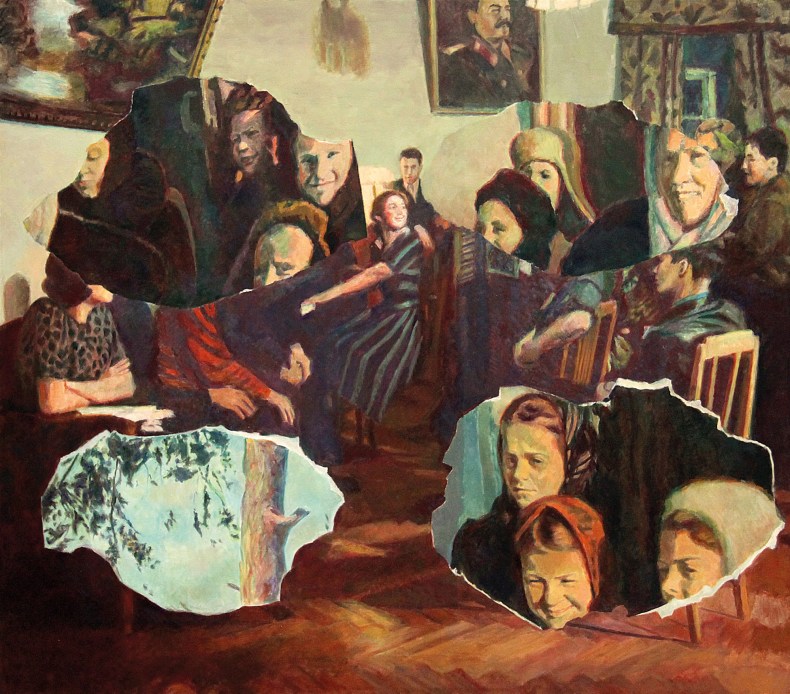
The Collage of Spaces #6 (2010), Ilya Kabakov. © Ilya and Emilia Kabakov
It’s not just the failure of a particular 20th-century stab at utopia that preoccupies the Kabakovs. In the last few years, Ilya Kabakov has been working on a series of ‘collage’ paintings, large-scale narrative paintings, which layer a series of fragmented scenes of people or landscapes on to unconnected interiors or landscapes in ways that make it hard to decide what’s background and foreground. In The Collage of Spaces #6 (2010), in the centre of a room where a portrait of Stalin hangs, and in the centre of the composition, a girl plays a piano, with an additional audience of faces beamed in from an unknown elsewhere. This deliberate blurring of time and space seems part of his interest in achieving a kind of universality for his own work, one that outlasts any tilting at the art of the Soviet period. ‘The history of Russia and 19th-century painting is a tragic story,’ Ilya Kabakov says, ‘because of the difference compared to Russian music and literature. Russian visual art is not integrated into the history of international art, it’s still local art.’
Ilya Kabakov is an intriguing combination of internal self-doubt (Emilia jokingly refers to it as ‘a psychological defect now’) and huge ambition (which could not be realised without her). ‘My mind works in a way that I’m never sure about what I’m doing,’ Ilya says. ‘For me it’s not what I’m doing, it’s the person looking at my work that’s more important.’ And who is the viewer? ‘It’s the viewer who will look at my work when I am not here […] It’s a museum viewer, it’s not a collector. The museum for me is a sacred place. This is the ideal – this is Wimbledon – that exists in my head.’
‘Not Everyone Will Be Taken Into the Future’ is at Tate Modern, London, from 18 October–28 January 2018.
From the October 2017 issue of Apollo: preview and subscribe here.
Unlimited access from just $16 every 3 months
Subscribe to get unlimited and exclusive access to the top art stories, interviews and exhibition reviews.

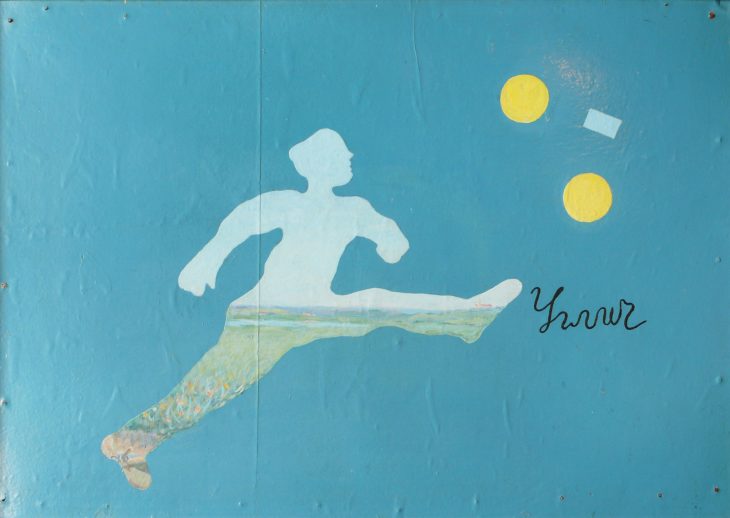
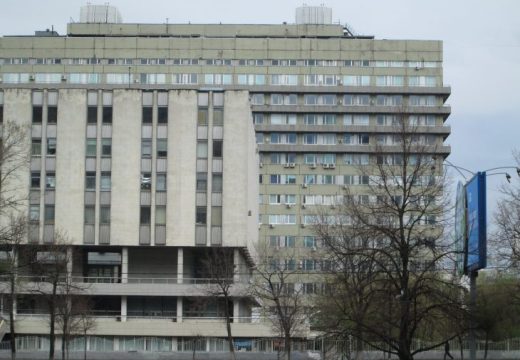
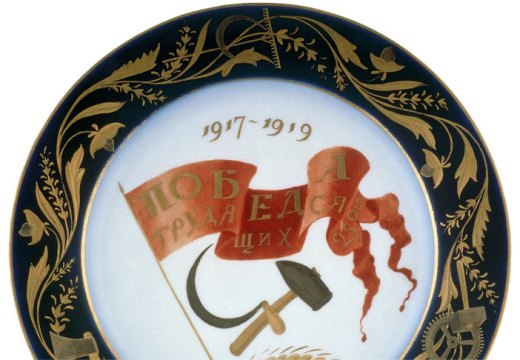
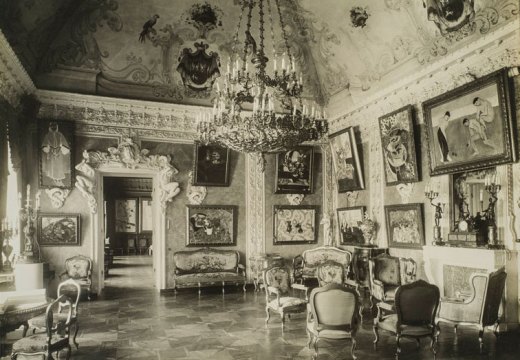









![Masterpiece [Re]discovery 2022. Photo: Ben Fisher Photography, courtesy of Masterpiece London](http://www.apollo-magazine.com/wp-content/uploads/2022/07/MPL2022_4263.jpg)
It’s time for the government of London to return to its rightful home